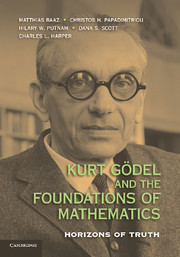Book contents
- Frontmatter
- Contents
- Contributors
- Foreword
- Preface
- Acknowledgments
- Short Biography of Kurt Gödel
- I Historical Context: Gödel's Contributions and Accomplishments
- Gödel's Legacy: A Historical Perspective
- The Past and Future of Computation
- 7 Computation and Intractability: Echoes of Kurt Gödel
- 8 From the Entscheidungsproblem to the Personal Computer – and Beyond
- Gödelian Cosmology
- II A Wider Vision: The Interdisciplinary, Philosophical, and Theological Implications of Gödel's Work
- Gödel and the Mathematics of Philosophy
- Gödel and Philosophical Theology
- Gödel and the Human Mind
- III New Frontiers: Beyond Gödel's Work in Mathematics and Symbolic Logic
- The Realm of Set Theory
- Gödel and the Higher Infinite
- Gödel and Computer Science
- Index
8 - From the Entscheidungsproblem to the Personal Computer – and Beyond
Published online by Cambridge University Press: 07 September 2011
- Frontmatter
- Contents
- Contributors
- Foreword
- Preface
- Acknowledgments
- Short Biography of Kurt Gödel
- I Historical Context: Gödel's Contributions and Accomplishments
- Gödel's Legacy: A Historical Perspective
- The Past and Future of Computation
- 7 Computation and Intractability: Echoes of Kurt Gödel
- 8 From the Entscheidungsproblem to the Personal Computer – and Beyond
- Gödelian Cosmology
- II A Wider Vision: The Interdisciplinary, Philosophical, and Theological Implications of Gödel's Work
- Gödel and the Mathematics of Philosophy
- Gödel and Philosophical Theology
- Gödel and the Human Mind
- III New Frontiers: Beyond Gödel's Work in Mathematics and Symbolic Logic
- The Realm of Set Theory
- Gödel and the Higher Infinite
- Gödel and Computer Science
- Index
Summary
Gödel's classic paper of 1931 did not settle Hilbert's Entscheidungsproblem. The young logician Alan Turing took up the problem and, in the course of his attack, conceived the basic principle of the modern computer – the idea of controlling the machine's operations by means of a program of coded instructions stored in the computer's memory. The transition from mathematical logic to electronic hardware took twelve years (1936–1948), and Turing played a central role in this transformation.
In a reference to Turing's famous paper of 1936, “On Computable Numbers, with an Application to the Entscheidungsproblem,” one of the pioneers of the electronic computer, John Womersley, aptly described the new machines as “Turing in hardware” (Womersley, 2005 [1946], 39). With Gödel's (1931) introduction of the idea of representing logical and arithmetical statements as numbers, together with his foundational contributions to recursion theory, the new machines might also be described, in a more distant sense, as “Gödel in hardware.” Gödel himself, however, took little interest in the development of the electronic computer (Wang, 1987, 171).
By what steps did the logicomathematical results of the 1930s lead to the modern stored-program digital computer? The answer offered by computing folklore runs “von Neumann … ENIAC … EDVAC.… Princeton”; the true story is rather different, however. This chapter charts the development of the electronic stored-program digital computer, from the extraordinary Colossus computers built for code breaking during World War II to the first successful run of a stored program in 1948.
Information
- Type
- Chapter
- Information
- Kurt Gödel and the Foundations of MathematicsHorizons of Truth, pp. 151 - 182Publisher: Cambridge University PressPrint publication year: 2011
Accessibility standard: Unknown
Why this information is here
This section outlines the accessibility features of this content - including support for screen readers, full keyboard navigation and high-contrast display options. This may not be relevant for you.Accessibility Information
- 2
- Cited by
